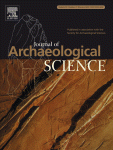| New Volume/Issue is now available on ScienceDirect |
| | Original Research Articles | |
| | 4. | Neolithic Hedgehogs (Erinaceus europaeus) from the Island of Gotland show early contacts with the Swedish mainland Original Research Article
Pages 229-233
Magdalena Fraser, Sabine Sten, Anders Götherström
Highlights► Phylogeographic studies of animals can be a proxy for prehistoric human contacts. ► Hedgehogs first appear on the Island of Gotland during the Neolithic. ► Results show that the Neolithic hedgehogs belong to theErinaceus europaeusvariety. ► The ancient hedgehog mitotypes coincide with extant mitotypes in Sweden. ► Thus indicating early contacts with the Swedish mainland.
| |
| | 5. | Using provenance data to assess archaeological landscapes: an example from Calabria, Italy Original Research Article
Pages 234-246
Kostalena Michelaki, Ronald G.V. Hancock, Gregory V. Braun
Highlights► Clay sediments from southwestern Calabria, Italy examined. ► Properties of sediments assessed by field experiments and multiple laboratory analyses. ► Three different sediment units identified corresponding well with geological units. ► Implications for landscape and ceramic analyses considered.
| |
| | 6. | From the modern to the archaeological: starch grains from millets and their wild relatives in China Original Research Article
Pages 247-254
Xiaoyan Yang, Jianping Zhang, Linda Perry, Zhikun Ma, Zhiwei Wan, Mingqi Li, Xianmin Diao, Houyuan Lu
Highlights► Starch grains from 31 modern samples of millet derived from 9 species were analyzed. ► A dichotomous key is set up to partition the starch assemblage into taxonomic groups. ► Ancient starch grains from broomcorn millet were compared with the modern data. ► Morphological features will allow for solid identification of ancient starch grains. ► Size classes will be helpful but not be dependable taxonomic indicators.
| |
| | 7. | Iron and bronze production in Iron Age IIA Philistia: new evidence from Tell es-Safi/Gath, Israel Original Research Article
Pages 255-267
Adi Eliyahu-Behar, Naama Yahalom-Mack, Sana Shilstein, Alexander Zukerman, Cynthia Shafer-Elliott, Aren M. Maeir, Elisabetta Boaretto, Israel Finkelstein, Steve Weiner
Highlights► Anin situIron Age IIA smithy was identified at Tell es-Safi/Gath. ► Two features were identified; a pit used for iron smelting and a forging hearth. ► Thein situslag was identified as a bloomery slag. ► We suggest a possible explanation for the scarcity of evidence for iron working.
| |
| | 8. | Dating Aboriginal stone-walled fishtraps at Lake Condah, southeast Australia Original Research Article
Pages 268-286
Ian J. McNiven, Joe Crouch, Thomas Richards, Nic Dolby, Geraldine Jacobsen
Graphical abstractExcavations at a large Aboriginal freshwater fishtrap at Lake Condah, western Victoria, Australia, indicate initial channel construction by removal of basalt lava blocks around 6600 years ago, with basalt block walls added to the sides of the channel within the past 800 years.
 Highlights►New archaeological approach to dating fishtraps. ►First direct dating of fishtraps at Lake Condah, Australia. ►These traps were first constructed at least 6600 years ago. ►The traps are amongst the oldest known in the world.
| |
| | 11. | Migration and Viking Dublin: paleomobility and paleodiet through isotopic analyses Original Research Article
Pages 308-320
Kelly J. Knudson, Barra O’Donnabhain, Charisse Carver, Robin Cleland, T. Douglas Price
Highlights► We use biogeochemistry to investigate paleodiet and paleomobility in Viking Dublin. ► There are no Scandinavian immigrants in ninth through twelfth-century contexts. ► These data support acculturation rather than many first-generation immigrants.
| |
| | 13. | Red deer antler technology and early modern humans in Southeast Europe: an experimental study Original Research Article
Pages 332-346
José-Miguel Tejero, Marianne Christensen, Pierre Bodu
Highlights► We describe the procedure used to obtain antler blanks by splitting in the Aurignacian. ► We created a reference base for interpreting archaeological remains produced by splitting. ► The efficacy of this procedure for the exhaustive exploitation of antler is demonstrated. ► This procedure allows us to obtain the standard blanks observed in the Spanish Aurignacian.
| |
| | 14. | Simulating archaeologists? Using agent-based modelling to improve battlefield excavations Original Research Article
Pages 347-356
Xavier Rubio Campillo, Jose María Cela, Francesc Xavier Hernàndez Cardona
Highlights► Simulation is used to validate the methodology used in battlefield archaeology. ► All the steps that influence research are covered, from battle to excavation. ► Archaeology is able to understand a battle even if 95% of original data is lost. ► Results suggest a number of guidelines to improve survey techniques. ► The paper shows how computer simulation can be used to explore methodological topics.
| |
| | 15. | Diversity of cultivars and other plant resources used at habitation sites in the Llanos de Mojos, Beni, Bolivia: evidence from macrobotanical remains, starch grains, and phytoliths Original Research Article
Pages 357-370
Ruth Dickau, Maria C. Bruno, José Iriarte, Heiko Prümers, Carla Jaimes Betancourt, Irene Holst, Francis E. Mayle
Highlights► Archaeobotanical analysis of sediments and artifacts from Bolivian Amazon. ► Use of multiple techniques. ► Diversity of crops including maize, manioc, squash, peanuts, and cotton. ► Economic basis of dense population and complex society.
| |
| | 16. | Potash – a key raw material of glass batch for Bohemian glasses from 14th–17th centuries? Original Research Article
Pages 371-380
Zuzana Cílová, Jiří Woitsch
Highlights► Raw materials for glassmaking were made according to early-modern technologies. ► Differences in the composition of potashes made of different types of ashes revealed. ► Laboratory melted glass composition compared with archaeological findings. ► Batch composition in Bohemia that differs from previously published papers suggested. ► 3-component batch (quartz, beech ash, potash) was used in Czech medieval glassworks.
| |
| | 17. | Seasoned or green? Radial cracks analysis as a method for identifying the use of green wood as fuel in archaeological charcoal Original Research Article
Pages 381-388
Isabelle Théry-Parisot, Auréade Henry
Highlights► Do radial cracks (RC) on wood charcoal result from the combustion of green wood? ► To answer this question, we analysed 272 experimental charcoal samples of Scots Pine. ► Radial Cracks were identified on all – green and seasoned – wood samples. ► Thus, RC cannot be interpreted as resulting from the use of green wood in a hearth. ► But the mean number of RC per square millimetre allowed discriminating green wood from seasoned wood.
| |
| | 18. | Aspects of ancient Greek trade re-evaluated with amphora DNA evidence Original Research Article
Pages 389-398
Brendan P. Foley, Maria C. Hansson, Dimitris P. Kourkoumelis, Theotokis A. Theodoulou
Highlights► Trace DNA of amphora contents persists in empty jars after recovery from underwater. ► Ancient DNA can be collected non-destructively from jars using nylon swabs. ► Ancient DNA from random sample of amphoras seldom indicates wine as trade good. ► Ancient DNA of olive and herbs commonly detected in amphoras.
| |
| | 19. | Persistence of the cultural landscape in Campania (Southern Italy) before the AD 472 Vesuvius eruption: archaeoenvironmental data Original Research Article
Pages 399-406
E. Allevato, M. Buonincontri, M. Vairo, A. Pecci, M.A. Cau, M. Yoneda, G.F. De Simone, M. Aoyagi, C. Angelelli, S. Matsuyama, K. Takeuchi, G. Di Pasquale
Highlights► Cultural landscape in late Antiquity at the northern slope of Vesuvius. ► Charcoal analysis,14C dating and chemical analysis of organic residues. ► Active economic system in late Antiquity with a remarkable agrarian landscape and wine production. ► The most ancient evidence of chestnut silviculture for wood.
| |
| | 22. | Directional analysis of surface artefact distributions: a case study from the Murghab Delta, Turkmenistan Original Research Article
Pages 428-439
Steven Markofsky, Andrew Bevan
Highlights► Exploration of anisotropy (directionality) in surface artefact distributions. ► Two methods: geostatistics/variography and angular wavelet analysis. ► Depositional/post-depositional processes behave differently in different directions. ► Watercourses influence anisotropy in surface scatter; sand dunes cause recovery bias. ► Important to consider directional influences in sampling methodologies.
| |
| | 24. | Modeling Late Copper Age demographics on the Great Hungarian Plain using ceramic petrography Original Research Article
Pages 458-466
Timothy A. Parsons
Highlights► Diachronic change in ceramic composition as demographic indicator. ► Petrographic analysis to observe changes in ceramic manufacturing technology. ► Abrupt changes in ceramic manufacturing technology may indicate migration into a region. ► Little diachronic change in ceramics on prehistoric Hungarian Plain. ► Migration not supported as a catalyst for material changes in Late Copper Age.
| |
| | 27. | Uranium-series age estimates for rock art in southwest China Original Research Article
Pages 492-499
Paul S.C. Taçon, Maxime Aubert, Li Gang, Yang Decong, Liu Hong, Sally K. May, Stewart Fallon, Ji Xueping, Darren Curnoe, Andy I.R. Herries
Highlights► We report the first uranium-series age estimates for rock art in China. ► A large painted deer head was dated to between 5738 and 2050 years. ► Older naturalistic paintings underlie the deer head, at least 3400 years old. ► This is the oldest dated rock art in China.
| |
| | 30. | Method for photogrammetric surveying of archaeological sites with light aerial platforms Original Research Article
Pages 521-530
A.T. Mozas-Calvache, J.L. Pérez-García, F.J. Cardenal-Escarcena, E. Mata-Castro, J. Delgado-García
Highlights► We develop a method for performing photogrammetric surveying using light platforms. ► The method allows the execution of the flight following the planned parameters. ► A miniprism and a robotized total station are used for guiding the platform. ► The methodology is applied to an archaeological site in Southern Spain. ► The results obtained have demonstrated the viability of this method.
| |
| | 31. | Understanding the rates of expansion of the farming system in Europe Original Research Article
Pages 531-546
Jean-Pierre Bocquet-Appel, Stephan Naji, Marc Vander Linden, Janusz Kozlowski
Highlights► Longitudinal acceleration of the Neolithic pioneer front in the European EW direction. ► Acceleration of inland and marine expansion coincide with the 8200 calBP event. ► Expansion is negatively correlated with the intensification of agricultural system. ► Expansion is also negatively correlated with demographic density. ► Expansion is slow in closed ecosystems with an intensive farming system.
| |
| | 32. | Archaeological microgravimetric prospection inside don church (Valencia, Spain) Original Research Article
Pages 547-554
Jorge Padín, Angel Martín, Ana Belén Anquela
Highlights► Microgravimetric prospection has been done in Don church, Valencia. ► A buried crypt, suggested by different boreholes, has been confirmed. ► The reduction for the inner building gravimetric effect is extensively studied.
| |
| | 33. | Tracking changes in bone fracture morphology over time: environment, taphonomy, and the archaeological record Original Research Article
Pages 555-559
Landon P. Karr, Alan K. Outram
Highlights► Macroscopic bone fracture morphology can be used as an indicator of rates of bone degradation. ► Frozen bones degrade predictably over time. ► Rapid changes in fracture morphology in hot, dry conditions can obscure bone fracture evidence. ► Rates of bone degradation vary between different environments and affect archaeological interpretation. ► Rapid bone degradation may explain some anomalies in the archaeological record.
| |

Núcleo de Arqueologia e Paleoecologia Laboratório G22 FCHS - Departamento de História, Arqueologia e Património Universidade do Algarve Campus de Gambelas 8005-139 Faro, PORTUGAL Mail: nap.ualg@gmail.comUrl: http://nap-ualg.blogspot.com
|





